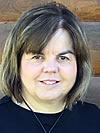
Susan Beck
University of Arizona
2017 George P. Woollard Award
Presented to Susan Beck
Citation by Gene Humphreys
Subduction dominates the geological and geophysical processes of continental growth and the creation of continental structure. Because subduction’s important processes and consequences occur far below the surface, they have been revealed primarily through indirect means, and hard work. Sue Beck has been one of subduction’s most persistent and successful observers. To witness subduction in the act, Sue and coworkers image its underlying structure using broadband seismometers deployed over the region of investigation. This is difficult work, often in remote and logistically challenging regions.
Sue’s earliest studies were of earthquake rupture. Her work soon expanded to include structural studies of the upper plate crust and mantle, the subduction interface, the subducted slab (flat and normal), and the mantle wedge. Her work has focused on the diverse subduction environments of South America, although she has also contributed meaningfully to understanding the North America cordillera and Turkish orogeny. The rewards of these efforts have helped define our modern understanding of subduction and its geologic consequences in its many environments.
Her work is best viewed as a comprehensive undertaking, and this body of work has really made a difference. It is characterized by an aim at important problems, and her work is typified by integration. And it is done carefully. To suggest that she alone has done this work is to miss the point; rather she is the cheerful yet serious lead in a broad-based effort. This, it seems, is how she wants it. Sue is a community-oriented scientist typifying an approach that is increasingly fundamental to our field.
Sue has contributed more service than any three normal individuals. To mention just two contributions, the strength of Earth science at the University of Arizona, and of seismology enabled by IRIS, owe much to her leadership as chair of each for many years.
 2017 George P. Woollard Award — Response by Susan Beck
2017 George P. Woollard Award — Response by Susan Beck
Gene, thank you so much for the kind words and thanks to the GSA and the Geophysics Division. I am surprised and excited to receive the George P. Woollard Award for contributions to geology using geophysics.
First and foremost, I want to thank George Zandt, my partner in both life and work. Together we have had more fun than most people, trying to unravel the mysteries of the Andes as well as many other mountain belts and subduction zones. We were fortunate to be able to create a synergy that made work fun, take us to incredible places to collect seismic data for our analyses, and work with amazing colleagues and students for the past 30 years.
I got a strong geologic background at the University of Utah and a strong seismology foundation at the University of Michigan. Both schools emphasized the importance of integrating geology and geophysics to understand the Earth. But most importantly, I absorbed a passion for geoscience from both Ron Bruhn, my M.S. advisor, and Larry Ruff, my Ph.D. advisor. I was finishing graduate school when the IRIS consortium was formed and I benefited greatly from its growing influence on our field. IRIS changed the culture of seismology that gave rise to a community spirit that continues to foster support and encouragement to seismologists. I have been very fortunate to be a part of a vibrant community in both seismology and tectonics in the U.S. and internationally that share ideas and provides encouragement.
Like most research in geoscience my work is not done in a vacuum. My fellow graduate students at UM, Susan Schwartz, Doug Christensen, and Chris Lynnes, were always pushing and challenging me and taught me the value of having colleagues to bounce ideas off of. I have had the privilege to work with great collaborators over the years, including Lara Wagner, Maureen Long, Carmie Garzione, Donna Whitney, and Anne Meltzer. I especially want to thank Thorne Lay for engaging conversations about the Earth and sage advice over the years. When I first arrived at Arizona, Peter Coney told me to go after first-order problems and leave the “mop-up” work to others. At the University of Arizona, I am part of a vibrant department that integrates geology and geophysics seamlessly. I want to thank all my colleagues in the department for never letting me forget that the goal is to understand the Earth and have fun doing it. Peter Coney, George Davis, and Peter DeCelles have been especially influential in guiding my integration of geology and geophysics.
I have also been fortunate to have worked with and continue to work with many outstanding graduate students and postdocs over the years. It is often the graduate students and postdocs who do much of the work and who continue to make it exciting. I can’t name all the students, but I do want to mention a few: Stephen Myers, Mark Tinker, Jennifer Swenson, Patricia Alvarado, Josh Calkins, Lara Wagner, Megan Anderson, Arda Ozacar, Andy Frassetto, Berk Biryol, Christine Gans, Lepolt Linkimer, Ryan Porter, Alissa Scire, Jamie Ryan, Kevin Ward, Jonathan Delph, Brandon Bishop, Daniel Portner, and Clint Koch. Postdocs Dave Baumont, Hersh Gilbert, Linda Warren, and Colton Lynner contributed greatly to our program. And finally, I want to thank all our international colleagues that have made work in South America and Turkey not only possible but also fun. It remains an exciting time to be doing seismology and tectonics.
